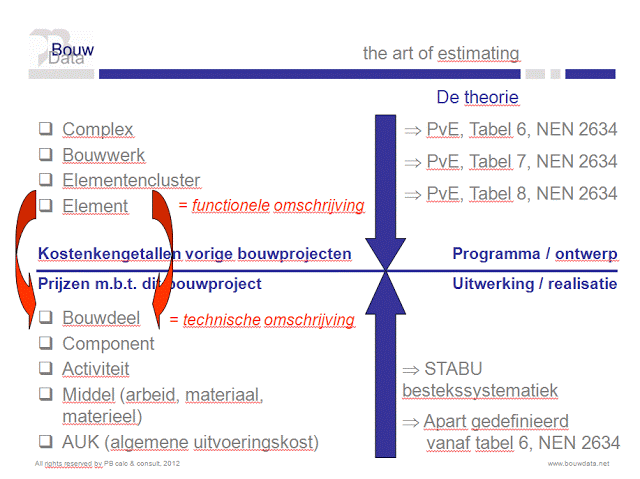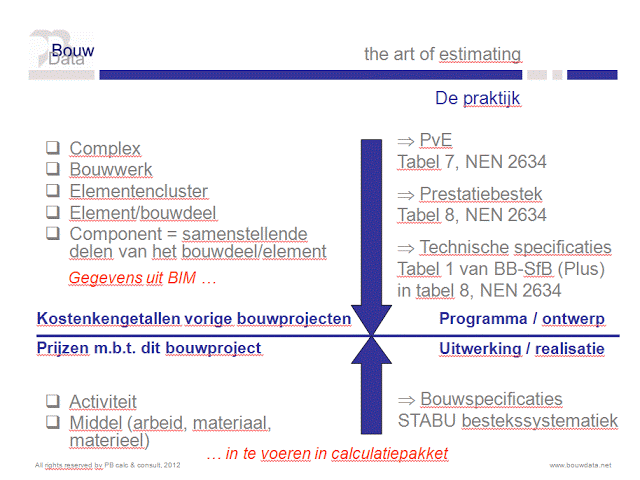Before moving on, it is important to be sure that we all speak the same language. Especially for the interpretation of the NEN 2634 this is important. So here a little lexicon made by the university of Delft:
- COMPLEX (same word can be used as well in Dutch as in English)
This is a collection of buildings who are somehow related to one another
- BOUWWERK or building in English
This is the complete collection of functional and/or physical objects needed to give a solution to the need of housing (this can be a real house or a factory, hospital, school, etc. but not a road or bridge or solution for traffic)
In the NEN 2634 the division of costs on this level is defined in table 6
An exemple: 2 bouwkundige werken or, in English, constructional works
- ELEMENTENCLUSTER or a cluster of elements in English
This is a group of elements with related characteristics
In the NEN 2634 the division of costs on this level is defined in table 7
An exemple: 2A fundering or, in English, foundation
- ELEMENT (same word can be used as well in Dutch as in English)
This is a functional object with a specific purpose belonging to a building without being related to a specific physical solution.
An element has a one-to-one relation to a building part
In the NEN 2634 the division of costs on this level is defined in table 8An exemple: 2A.13 lagen op grond or, in English, layers on soil, explained as a layer designed to carry 3 t/m² and with a flatness of 5mm over a 2m length
- BOUWDEEL or building part in English
This is a physical object with a specific performance just because of the materials used and the way it is constructed.
A building part has a one-to-one relation to an element
The layer on soil described as an element can also be described as a building part and it sounds like this: a layer on soil made out of 20cm concrete C25/30 with 25kg/m³ steel fibers on a PE foil of 0,2mm and layers of 5cm sand and 30cm of chippings
- COMPONENT (same word can be used as well in Dutch as in English)
These are the physical objects with a specific performance where building parts are made of.
The NEN 2634 stops at the level of element but when you look beyond the summary of table 1 of SfB you find everywhere on the internet, you see something usefull.
Especially when you look into the BB/SfB-plus which prof. Frank De Troyer from the University of Leuven published in 2008.
An exemple: 2A.13.0 - demolition, excavation for layers on soil
- ACTIVITEIT or activity in English
This is a process of putting into work materials using labor and equipment
Here, we enter back into the field of the material code and, as I wrote in one of my previous blogs, STABU is here much more usefull than the table 2 and 3 of SfB.
One can say that the activities are the molecules of an estimation
- MIDDEL or means in English
This is a general information carrier for building materials, labor or equipment
One can say that the means are the atoms of an estimation
Sounds interesting, doesn't it ? Certainly when you put it into a nice PPT slide:

I thought so as well when I started to put it into daily practice.
It didn't take long to figger out that this was all too theoretical.
Let me give you an exemple: 2D.31 exterior wall openings.
The idea is to have cost knowledge on a very rudimentary level when designing: a cost per square meter opening. This implicates that, when you want to put detailed estimations into a database, that you put the costs for big megadoors, ordinary windows and doors and automatic entrance doors all together in a big blender to generate the cost indicator of the exterior wall openings for that particular project.
So, I did.
But I ended up spending a lot of time writing down what the result really meant and when I needed to use the database I always felt very insecure.
On top of that, when I looked at table 6, I felt I didn't have the means to make proper distinctions between the different mass studies I had in front of me.
I had to figger out something else.
And the answer was quite easy: move everything one phase up !
So, my nice PPT slide now looks like this:

I'm using it now for a couple of years and it never has let me down !
Kind regards,
Peggy
www.bouwdata.net
